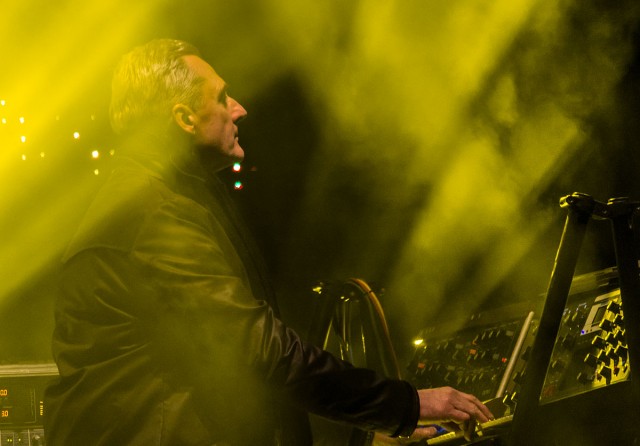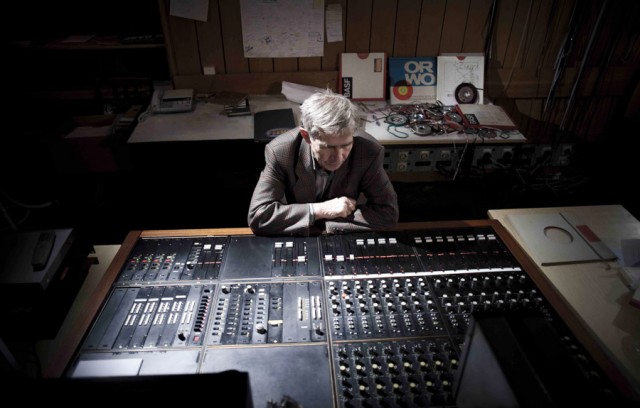
Marek Biliński helms a Moog live in Warsaw, 2013. Photo (CC-BY-SA) Robert Drózd.
The setting looks futuristic — like Stanley Kubrick teamed up with Syd Mead to make a theme park. But it’s actually Warsaw and environs. And the path the future is via the past, and a history largely unknown outside of the country. Boiler Room, best known for webcasting parties, shifts gears from what’s new-and-hip to where it all began, and the result is inspiring.
The film was directed by Marcin Filipek for Boiler Room with the input of Gosia Herman of Boiler Room Poland, and is the result of half a year spent gathering artists. The stunning imagery is the work of cinematographer Michal Dabal.
The strongest part of the film is unquestionably its glimpse of early Polish pioneers, and the challenges they faced as they carved a path through new electronic musical frontiers. So, you get:
- Marek Biliński: creator of the first synth album in Poland (check out his YouTube channel)
- Eugeniusz Rudnik: the experimental composer and founder of Experimental Studio of Polish Radio
- Władysław Komendarek: the experimental (prog rock gone beautifully haywire) musician who “highlights the importance of mutiny.”
The film also makes a connection to today’s musical generation in Poland, with younger artists:
Mikołaj “Noon” Bugajak
Bartosz “The Phantom” Kruczyński
Tomasz Twardowski
Synth-pop duo Rebeka (Iwona Skwarek and Bartosz Szczęsny)
Here, the filmmakers have a tougher job, simply because they’re narrowing down a now-enormous scene to a matter of a few minutes. (Imagine profiling Canadian electronic music in that time, for instance.) Poland is now one of the world’s major hubs for electronic music, home of course to Unsound Festival but with countless artists making a name for themselves in various genres. (Boiler Room Poland alone should keep you plenty busy.) Anyway, hopefully this piques some interest and those not already following the vibrant Polish scene (at home and abroad) start to pay it more mind.
It’s a definitely must-watch film, and a great starting point:
I’ve talked to various Polish friends (living in Poland and ex-pats), and heard all positive reviews for the film – particularly for the take on experimental legends who inspired them. And even Polish folks found something new in the film. Yes, there’s an alcohol sponsor; I’m glad when brands sponsor something meaningful like this.
Of course, there’s plenty more to say.
Now that I’ve got your attention, let’s let Marek Biliński take us on a whimsical trip through outer space, in an animation by Justyna Stefańczyk entitled “Kosmiczna wyprawa.” (“Space trip.” Uh… actually, you probably guessed that.)
And for a deeper, stranger trip, Eugeniusz Rudnik’s music is out there – sounds from decades ago sound somehow even more relevant today, with our attuned-to-weirdness, ready-to-open-the-airlock ears:
If the Boiler Room film seemed too short, here’s a 56-minute Polish documentary subject film (don’t worry, there are English subtitles) with Rudnik as source. The film by director/writer Zuzanna Solakiewicz reimagines his life as a form of sonic archeology, finding “love and passion” in French pronunciation. Actually, I give up, just watch:
"15 stron świata" / "15 cornes of the world" from Culture.pl on Vimeo.

Rudnik in a photo by Ula Klimek / UNSOUND’12, frame from “15 stron świata” / “15 cornes of the world”
Bonus, here’s a lovely visualization of Rudnik’s work done as a student project by Jan Dybala:
Eugeniusz Rudnik – excerpt by jan dybala from Jan Dybala JD Video on Vimeo.
Eugeniusz Rudnik talks to the Museum of Modern Art (NY)’s blog “post” about those heady days, and reflects on his trip from engineer to musician:
How much Rudnik is in Penderecki, and how much Rudnik is in Nordheim? Interview with Eugeniusz Rudnik [post.at.moma.org]
It’s worth checking out MOMA’s massive online feature on Poland.
That includes an archive of early electro-acoustic listening assembled from Polish Radio by researcher Magdalena Moskalewicz:
Magnetic Tape as Instrument: A Rare Selection of Electroacoustic Music from Poland
— plus an article on “spatial design” and sound that includes works you’ve probably never heard of that exchanges ideas with Iannis Xenakis’ polytopes. Even more stunning (to me, anyway) is a glove-based wearable, the “Personal Instrument (Instrument Osobisty)” by Krzysztof Wodiczko, that predicts the (significantly later) work on “The Hands” by Michel Waisvisz.
Spatial Music: Design and the Polish Radio Experimental Studio
For more:
Polish Radio Experimental Studio: A Close Look
Finally, as part of this series, Władysław Komendarek did a full live set. Hey, this is Boiler Room, after all. Fortunately, what you get is a massive stack of keyboards, and then things get very wild – like what would happen if an alien species had invented prog rock. You know, in a good way. F***, yes, Poland. The audience seems pleasantly stunned, like they got lost in some looped pad at some point. Keep listening, because it keeps going in radically different directions.
Western knowledge of history from the former Cold War nations of the Warsaw Pact has been, until fairly recently, sadly limited. The Iron Curtain went both ways: the work of these creators had to contend with both Soviet policy and a Western world that had little interest in promoting innovations of their Eastern counterparts. But that situation has changed, as both history – and young artists – flood the newly-international, newly-connected electronic music scene worldwide.
That has included major efforts by the likes of CTM Festival, which used Berlin – the ideal east/west meeting point today as it was historically – as a jumping-off point. Since its early editions years ago to talk about Eastern, Central, and Southeastern European musical history and modern artists, in former East Berlin but also beyond. And, of course, I was just a couple of weeks ago in Latvia, witnessing as ex-Soviet sound tech was repurposed and re-engineered for a new century. And we’ve seen young electronic music engineers champion the work of Standa Filip, the pioneer from former Czechoslovakia. And the list goes on…
But that’s perhaps the point of the Internet age, the divided Europe of years ago turned precisely inside out. Borders have been blurred not just by geopolitics, European Union, and easyJet. Instantaneous data has made more people than begin to, say, dig through weird old electro-acoustic tapes – and party with one another, together and even in their browser. With deepening economic divides, the news is hardly all sunny. But connectedness and curiosity then becomes all the more important. In fact, if cities like Berlin have continued to grow as hubs, surely the unleashed creativity of eastern, central, and southeastern Europe is partly to credit.
Let’s finish out with some modern-day Boiler Room from Poland, with that in mind, to add more younger faces from Poland to those you see in the film.
For instance, there’s Jacek Sienkiewicz, label head of Recognition Records, playing live:
Kuba Sojka has a hugely virtuosic live set (hope we talk to Kuba more soon, in fact) which has me moving my feet around even late on a Monday night:
And for a DJ set, one of my all-time favorite Polish artists has to be Eltron John, aka Krakow’s own Marek Stuczyński (who I first saw in Krakow at while playing patchlab). Oh, sure. Laugh. You’d be dancing around embarrassingly if cameras were pointed at you and Eltron was in the room.
But that’s just Boiler Room. Poland’s men and women of electronic music are far too numerous to put in a single post. You’ll … just spot them around here. Oh yeah, and Poland, I’ll see you on 20 March (along with Andrzej Koper, Dot Dot with vj emiko, Weiss – Olech, and odaibe … speaking of “There Are Too Many Polish Artists To Cover In a Small Space.”) Czekamy na ciebie, Wrocław!